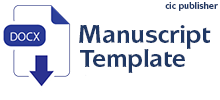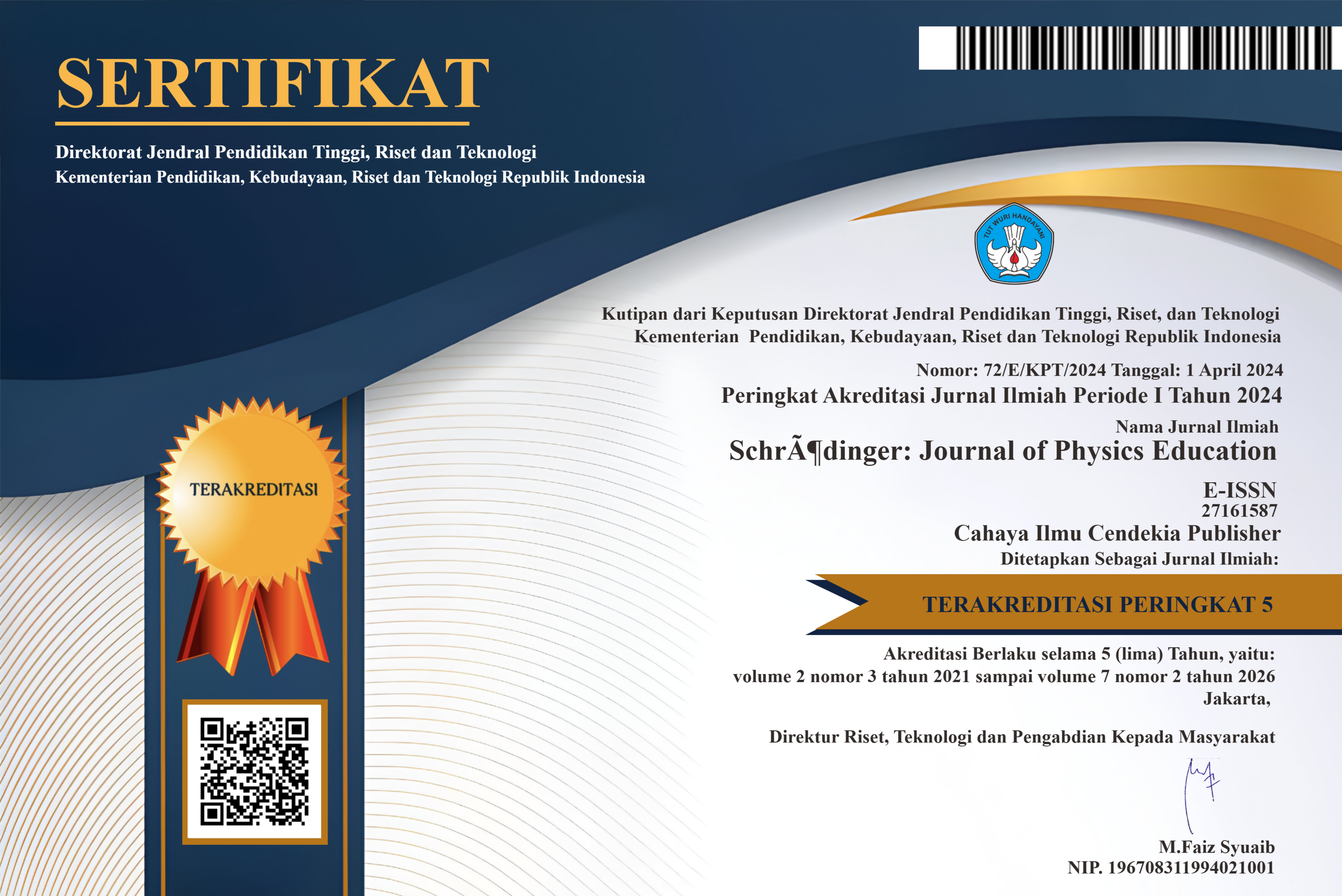Improving Science Learning Outcomes on Light and Optical Instruments Through Visual Methods in Junior High Schools
Abstract
Purpose of the study: to improve science learning outcomes about light and optical devices through visual methods (learning by observing and describing) in class VIII junior high school students.
Methodology: This type of research is classroom action research which is carried out in two cycles, namely cycle I and cycle II, each cycle contains planning, implementation, observation and reflection. The data collection method includes tests in the form of questions. Data analysis was carried out by calculating the achievement of learning outcomes for each cycle with an increase in classical completeness criteria, namely 85%.
Main Findings: The research results show an increase in student learning outcomes through visual methods (learning by observing and describing) on the topic of light and optical devices. This research was successful with the average score increasing from 57.85% to 65.18% in the pre-cycle, increasing 21.42% in the first cycle, and reaching a class average of 81.42% with 96.42% completeness in the first cycle. cycle II, exceeding the target of 85% for classical completeness.
Novelty/Originality of this study: The results of this research can contribute to scientific studies, especially on visual methods in learning in junior high schools. This research can be a guide for teachers to create interesting, effective and innovative learning, as well as increase students' enthusiasm for learning in science lessons through visual methods (learning by observing and imagining).
References
T. G. Ntuli and A. V. Mudau, “Pedagogical issues of Senior Phase teachers when teaching the matter and materials strand of natural sciences,” South African J. Educ., vol. 43, no. 2, pp. 1–7, 2023, doi: 10.15700/saje.v43n2a2194.
V. R. Downing, K. M. Cooper, J. M. Cala, L. E. Gin, and S. E. Brownell, “Fear of negative evaluation and student anxiety in community college active-learning science courses,” CBE Life Sci. Educ., vol. 19, no. 2, pp. 1–16, 2020, doi: 10.1187/cbe.19-09-0186.
E. Charamba, “Translanguaging in a multilingual class: a study of the relation between students’ languages and epistemological access in science,” Int. J. Sci. Educ., vol. 0, no. 0, pp. 1779–1798, 2020, doi: 10.1080/09500693.2020.1783019.
S. A. I. Permata, W. Sunarno, and H. Harlita, “Studi Literatur Double Loop Problem Solving (Dlps) Terhadap Kemampuan Pemecahan Masalah Ipa Siswa Smp,” INKUIRI J. Pendidik. IPA, vol. 10, no. 2, p. 108, 2021, doi: 10.20961/inkuiri.v10i2.57253.
E. Pellicano and J. den Houting, “Annual Research Review: Shifting from ‘normal science’ to neurodiversity in autism science,” J. Child Psychol. Psychiatry Allied Discip., vol. 63, no. 4, pp. 381–396, 2022, doi: 10.1111/jcpp.13534.
L. Cohausz, “When Probabilities Are Not Enough - A Framework for Causal Explanations of Student Success Models,” J. Educ. Data Min., vol. 14, no. 3, pp. 52–75, 2022, doi: 10.5281/zenodo.7304800.
N. Ramadani, L. J. Ananda, I. Rangkuti, E. B. Simanjuntak, and I. F. U. Manurung, “Analisis Minat Belajar Siswa Pada Pembelajaran IPA Kelas 4 di Sekolah Dasar Negeri 066054 Kec. Medan Denai T.A 2022/2023,” J. Student Dev. Inf. Syst., vol. 3, pp. 159–174, 2023.
A. A. Ogegbo and U. Ramnarain, “A systematic review of computational thinking in science classrooms,” Stud. Sci. Educ., vol. 58, no. 2, pp. 203–230, 2022, doi: 10.1080/03057267.2021.1963580.
N. N. Bett, C. Piccolo, N. D. Roberson, A. J. Charbonneau, and C. J. Addison, “Students’ Views on the Nature of Science in an Interdisciplinary First-Year Science Program: Content Analysis of a Weekly Reflection Activity,” Teach. Learn. Inq., vol. 11, 2023, doi: 10.20343/teachlearninqu.11.10.
Sudarsono, Kartono, Mulyono, and S. Mariani, “The Effect of STEM Model Based on Bima’s Local Cultural on Problem Solving Ability,” Int. J. Instr., vol. 15, no. 2, pp. 83–96, 2022, doi: 10.29333/iji.2022.1525a.
F. O. Widarta* and W. Artika, “Analisis Bentuk Stimulus, Dimensi Kognitif, dan Karakteristik HOTS pada Instrumen Evaluasi Mata Pelajaran IPA Karya Guru,” J. IPA Pembelajaran IPA, vol. 5, no. 3, pp. 197–208, 2021, doi: 10.24815/jipi.v5i3.21429.
E. B. Gumilar, “Problematika Pembelajaran Ipa Pada Kurikulum Merdeka Di Sekolah Dasar / Madrasah Ibtidaiyah,” J. Ilm. Pedagog., vol. 2, no. 1, p. 129, 2023.
A. Libunelo, S. Rahim, and G. Abdullah, “Pengaruh Penggunaan Media Flash Card Terhadap Hasil Belajar IPA Materi Perubahan Energi Kelas IV SDN 7 Limboto Barat Kabupaten Gorontalo,” Student J. Elem. Educ., vol. 1, no. 1, pp. 9–16, 2022, doi: https://ejournal-fip-ung.ac.id/ojs/index.php/SJEE/article/view/1315.
J. Medová, Z. Sedmáková, B. Uhrecký, and L. Valovičová, “Designing Activities to Develop Statistical Literacy in Primary Pupils While Conducting Physics Laboratory Work in Informal Settings,” Educ. Sci., vol. 12, no. 4, 2022, doi: 10.3390/educsci12040246.
M. Siponen and T. Klaavuniemi, “Demystifying beliefs about the natural sciences in information system,” J. Inf. Technol., vol. 36, no. 1, pp. 56–68, 2021, doi: 10.1177/0268396220901535.
R. Susanti, S. Kurniawan, and H. Tusadiyah, “Meningkatkan Hasil Belajar Ilmu Pengetahuan Alam pada Materi Perubahan Sifat Benda Melalui Metode Eksperimen Penelitian Tindakan di Madrasah Ibtidaiyah Raudhatul Mujawwidin Kelas V Kecamatan Rimbo Bujang,” J. Pendidik. Dasar Islam, vol. 1, no. 1, pp. 93–117, 2021.
P. A. Onanuga, A. S. Ifamuyiwa, and K. A. Alebiosu, “Learning-By-Doing Instructional Strategy and Parents’ Education in Determining Secondary Students’ Attitude in Agricultural Science,” J. Turkish Sci. Educ., vol. 18, no. 2, pp. 305–319, 2022, doi: 10.36681/tused.2021.68.
N. Hermita, M. Alpusari, E. Astuti Mulyani, A. Paura, and H. Herliana, “Enhancing Science Process Skills through Conceptual Teaching and Learning Related to Water-Savings and Natural Events Concept,” J. Educ. Sci., vol. 4, no. 1, p. 146, 2020, doi: 10.31258/jes.4.1.p.146-152.
D. Darmaji, A. Astalini, D. A. Kurniawan, and E. Triani, “The effect of Science Process Skills of Students Argumentation Skills,” J. Inov. Pendidik. IPA, vol. 8, no. 1, pp. 78–88, 2022, doi: 10.21831/jipi.v8i1.49224.
T. S. Moraga-Calderón, H. Buisman, and J. Cramer, “The relevance of learning quantum physics from the perspective of the secondary school student: A case study,” Eur. J. Sci. Math. Educ., vol. 8, no. 1, pp. 32–50, 2020, doi: 10.30935/scimath/9545.
S. Cai, C. Liu, T. Wang, E. Liu, and J. C. Liang, “Effects of learning physics using Augmented Reality on students’ self-efficacy and conceptions of learning,” Br. J. Educ. Technol., vol. 52, no. 1, pp. 235–251, 2021, doi: 10.1111/bjet.13020.
E. C. Goodwin, C. Shapiro, A. C. Freise, B. Toven-Lindsey, and J. Moberg Parker, “Synthesizing Research Narratives to Reveal the Big Picture: a CREATE(S) Intervention Modified for Journal Club Improves Undergraduate Science Literacy,” J. Microbiol. Biol. Educ., vol. 24, no. 2, pp. 1–14, 2023, doi: 10.1128/jmbe.00055-23.
S. Mutmainah and M. Muchlis, “Implementation of assessment for learning to improve students’ cognitive learning outcomes in the concept of chemical bonding,” J. Pijar Mipa, vol. 17, no. 2, pp. 217–223, 2022, doi: 10.29303/jpm.v17i2.3308.
H. O. Yeni, C. Anggraini, and F. Meilina, “Upaya meningkatkan hasil belajar siswa dalam pembelajaran IPA dengan menggunakan media visual pada siswa kelas IV SDN 002 Tebing kabupaten Karimun Tahun Ajaran 2017/2018.,” J. Pendidik. Minda, vol. 1, no. 2, pp. 10–18, 2020, doi: 10.1016/j.fcr.2017.06.020.
J. Zeng, S. Parks, and J. Shang, “To learn scientifically, effectively, and enjoyably: A review of educational games,” Hum. Behav. Emerg. Technol., vol. 2, no. 2, pp. 186–195, 2020, doi: 10.1002/hbe2.188.
H. Bakirci, M. G. Kirici, and Y. Kara, “The Effectiveness of STEM-Supported Inquiry-Based Learning Approach on Conceptual Understanding of 7th Graders: Force and Energy Unit,” J. Sci. Learn., vol. 5, no. 3, pp. 452–468, 2022, doi: 10.17509/jsl.v5i3.43647.
K. S. Adnyana and G. N. A. Yudaparmita, “Peningkatan Minat Belajar IPAS Berbantuan Media Gambar Pada Siswa Sekolah Dasar,” Edukasi J. Pendidik. Dasar, vol. 4, no. 1, p. 61, 2023, doi: 10.55115/edukasi.v4i1.3023.
T. W. Isma, R. Putra, T. I. Wicaksana, E. Tasrif, and A. Huda, “Peningkatan Hasil Belajar Siswa melalui Problem Based Learning (PBL),” J. Imiah Pendidik. dan Pembelajaran, vol. 6, no. 1, pp. 155–164, 2021, doi: 10.23887/jipp.v6i1.42726.
R. Suhada, I. Idrus, and Kasrina, “Peningkatan Hasil Belajar Siswa Melalui Penerapan Model Pembelajaran Discovery Learning,” Diklabio J. Pendidik. dan Pembelajaran Biol., vol. 3, no. 1, pp. 32–40, 2019, doi: https://doi.org/10.33369/diklabio.3.1.32-40.
K. L. Hughes, P. R. Williamson, and B. Young, “In-depth qualitative interviews identified barriers and facilitators that influenced chief investigators’ use of core outcome sets in randomised controlled trials,” J. Clin. Epidemiol., vol. 144, pp. 111–120, 2022, doi: 10.1016/j.jclinepi.2021.12.004.
Hamzah B. Uno, Teori Motivasi dan Pengukurannya: Analisis di Bidang Pendidikan. Jakarta: PT. Bumi Aksara, 2023.
R. M. Sølvik and A. E. H. Glenna, “Teachers’ potential to promote students’ deeper learning in whole-class teaching: An observation study in Norwegian classrooms,” J. Educ. Chang., vol. 23, no. 3, pp. 343–369, 2022, doi: 10.1007/s10833-021-09420-8.
Basrowi and Suwandi, Memahami Penelitian Kualitatif. Jakarta: Rhineksa Cipta, 2008.
C. Granberg, T. Palm, and B. Palmberg, “A case study of a formative assessment practice and the effects on students’ self-regulated learning,” Stud. Educ. Eval., vol. 68, no. November 2020, 2021, doi: 10.1016/j.stueduc.2020.100955.
H. Sholeh, Metode Edutainment. Yogyakarta: Diva Press, 2011.
E. Zahara, “Implementasi Model Pembelajaran Berbasis Proyek ( Project Based Learning ) Materi Luas Balok Dan Kubus Untuk Meningkatkan Semangat Belajar Peserta Didik Kelas V MIN 19 Bireuen,” Serambi Akad. J. Pendidikan, Sains, dan Hum., vol. XI, no. 9, pp. 1209–1214, 2023, doi: https://doi.org/10.32672/jsa.v11i9.7240.
D. K. Sri Astiti and I. W. Widiana, “Penerapan Metode Pembelajaran Jigsaw Sebagai Upaya Meningkatkan Hasil Belajar Ipa Pada Siswa Kelas Iv Sd,” J. Ilm. Sekol. Dasar, vol. 1, no. 2, pp. 30–41, 2017, doi: 10.23887/jear.v1i2.12043.
Copyright (c) 2024 Dewi Ria Retnani, Rina Royani, Christopher Beccles, Abderrachid Afras

This work is licensed under a Creative Commons Attribution 4.0 International License.
Authors who publish with this journal agree to the following terms:
- Authors retain copyright and acknowledge that the Schrödinger: Journal of Physics Education is the first publisher licensed under a Creative Commons Attribution 4.0 International License.
- Authors are able to enter into separate, additional contractual arrangements for the non-exclusive distribution of the journal's published version of the work (e.g., post it to an institutional repository or publish it in a book), with an acknowledgment of its initial publication in this journal.
- Authors are permitted and encouraged to post their work online (e.g., in institutional repositories or on their website) prior to and during the submission process, as it can lead to productive exchanges and earlier and greater citation of published work.







.png)
.png)








.png)
.png)
.png)







